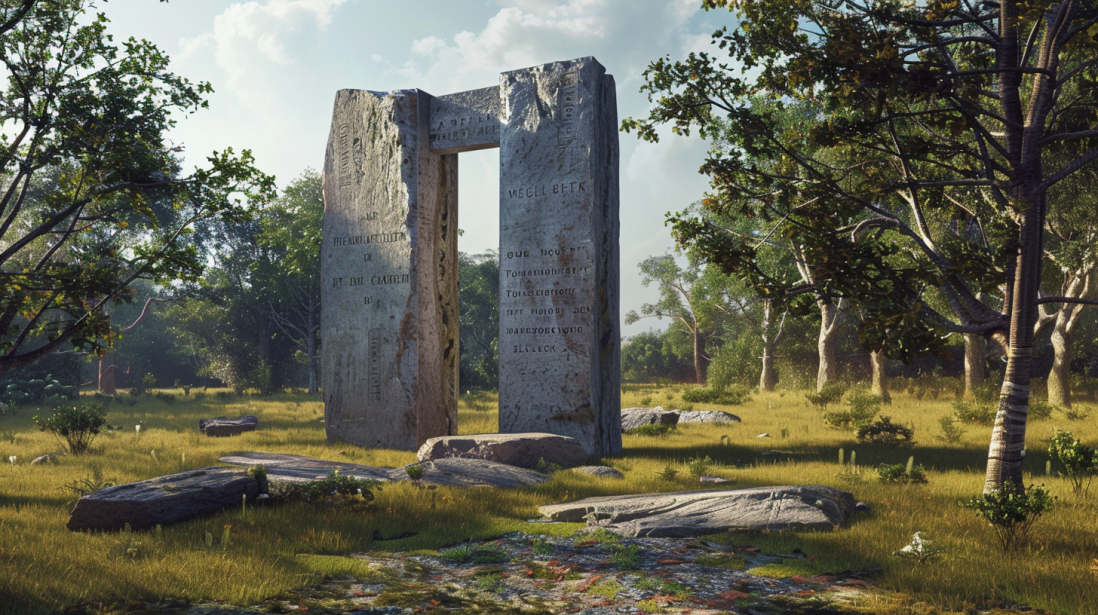Introduction
In 1980, the Georgia Guidestones, a massive granite monument with inscriptions in eight languages, were erected in Elbert County, Georgia. The true purpose and identity of the people who commissioned the monument remain unknown, sparking many theories and speculations. This article delves into the enigma of the Georgia Guidestones, exploring their history, messages, and the various interpretations they have inspired.
Description of the Guidestones
The Georgia Guidestones consist of four large upright slabs topped by a capstone, with a central pillar standing in the middle. The monument stands at approximately 19 feet high and is made of granite. The inscriptions on the Guidestones are written in eight languages: English, Spanish, Swahili, Hindi, Hebrew, Arabic, Chinese, and Russian.
Construction of the Monument
The monument was commissioned by a person or group using the pseudonym “R.C. Christian.” In 1979, R.C. Christian approached the Elberton Granite Finishing Company to construct the Guidestones, specifying the details and dimensions. The project was shrouded in secrecy, with R.C. Christian insisting on anonymity and paying for the construction through an intermediary.
Inscriptions and Their Messages
The Georgia Guidestones bear ten guidelines or principles engraved on them. These inscriptions have sparked considerable debate and interpretation. The guidelines are:
- Maintain humanity under 500,000,000 in perpetual balance with nature.
- Guide reproduction wisely — improving fitness and diversity.
- Unite humanity with a living new language.
- Rule passion — faith — tradition — and all things with tempered reason.
- Protect people and nations with fair laws and just courts.
- Let all nations rule internally resolving external disputes in a world court.
- Avoid petty laws and useless officials.
- Balance personal rights with social duties.
- Prize truth — beauty — love — seeking harmony with the infinite.
- Be not a cancer on the Earth — Leave room for nature — Leave room for nature.
The Identity of R.C. Christian
The name “R.C. Christian” is widely believed to be a pseudonym. Various theories suggest that the name could be a reference to the Rosicrucians, a secretive esoteric order. Despite numerous investigations, the true identity of R.C. Christian remains a mystery.
Purpose of the Guidestones
The intentions behind the Guidestones are speculative. Some believe they serve as a guide for rebuilding civilization after a catastrophic event. Others interpret them as advocating for a new world order or promoting environmental conservation. The ambiguous nature of the inscriptions leaves much room for interpretation.
Conspiracy Theories
The Guidestones have been the subject of many conspiracy theories. Some theorists claim they are a manifesto for a secret society aiming to control the world population. Others believe they are part of a globalist agenda. While these theories are popular, they often lack substantial evidence.
Public Reaction and Controversy
Public reaction to the Guidestones has been mixed. Some view them as a thought-provoking message for humanity, while others see them as controversial and ominous. The monument has been vandalized multiple times, reflecting the contentious nature of its messages.
Astronomical Features
The Guidestones are not just notable for their inscriptions but also for their astronomical features. The central pillar has an eye-level hole that aligns with the North Star, while a slot carved through the stone aligns with the solstices and equinoxes. These features suggest that the Guidestones were designed with celestial events in mind.
Cultural and Historical Context
The Guidestones were erected during a period of Cold War tension and environmental awakening. Comparisons can be made to other contemporary monuments and messages promoting global unity and environmental stewardship.
Media Coverage and Documentary Investigations
The media has extensively covered the Georgia Guidestones, with numerous documentaries exploring their origins and meanings. Notable investigations have been conducted by filmmakers and journalists, further fueling public interest and speculation.
Philosophical and Ethical Implications
The guidelines inscribed on the Guidestones raise significant philosophical and ethical questions. They touch on topics such as population control, global governance, and environmental ethics, prompting debates among scholars and the public.
Tourism and Economic Impact
The Georgia Guidestones have become a tourist attraction, drawing visitors from around the world. This has had economic benefits for Elbert County, providing a boost to local tourism and business.
Preservation Efforts
Preserving the Guidestones has been a challenge due to vandalism and natural wear. Efforts have been made to protect and maintain the monument, ensuring that it remains an enduring symbol of mystery and intrigue.
Modern Interpretations
Contemporary audiences continue to interpret the Guidestones in various ways. Some see them as a blueprint for a better future, while others view them with suspicion and skepticism. The relevance of their messages remains a topic of discussion.
Conclusion
The mystery of the Georgia Guidestones endures, with their purpose and the identity of their creators remaining unknown. The monument’s blend of cryptic messages, astronomical alignments, and secretive origins continues to captivate and intrigue. As new generations encounter the Guidestones, their legacy as a modern enigma is assured.
FAQs
What are the Georgia Guidestones?
The Georgia Guidestones are a granite monument erected in 1980 in Elbert County, Georgia, featuring inscriptions in eight languages that provide ten guidelines for humanity.
Who built the Georgia Guidestones?
The monument was commissioned by an anonymous individual or group using the pseudonym “R.C. Christian.”
What do the inscriptions on the Guidestones mean?
The inscriptions consist of ten guidelines that touch on themes such as population control, environmental conservation, and global governance. Their exact meaning is open to interpretation.
Why are the Georgia Guidestones controversial?
The Guidestones are controversial due to their enigmatic messages and the secrecy surrounding their origins, leading to various conspiracy theories and public debates.
Are the Georgia Guidestones still standing?
Yes, the Georgia Guidestones are still standing and continue to attract visitors and researchers interested in uncovering their mysteries.

